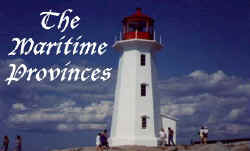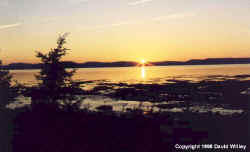 The Willey Travel Guide: Maritime Provinces (Part 1) - Ottawa to New Brunswick
By David and Christopher The call of the loon is a haunting cry heard throughout Canada but the mournful sounds of Canadians lamenting the drop in the value of the loonie (the Canadian dollar) is even more haunting. Nevertheless, this monetary "black cloud" does have a silver lining. More Canadians have taken the opportunity to explore their country this year. We were no different. I have been in the Maritimes before, but this was limited to business trips, generally in the winter. I had heard many stories describing the beauty of the Maritime provinces and the friendliness of its people. I now had an incentive to find out first hand. Planning: Being very busy at work in the early part of 1998, I did not really start thinking about our summer vacation until early July. This is exceptionally late for me and barely one month before we were scheduled to leave! I was beginning to worry whether we would have to sleep in the car. Quick research and planning was the order of the day. The internet came to the rescue and provided me with much needed information on the Maritime provinces. All three provinces had good web sites listing activities, sites and accommodation (for more information check out the following links: Nova Scotia, Prince Edward Island, New Brunswick). There is accommodation to suit all tastes, from camping to hotels. We focussed on our preferred accommodation: farm bed and breakfasts. When I started calling for availability I expected to be told that I was too late and that there was "no place at the inn". I was surprised to find that rooms were available at all of the locations I contacted, with the exception of B&B's in the Lunenburg area, where there was a Folk Music festival underway the day we wanted. I originally planned to stay in only three or four bed and breakfasts during the trip, using them as a base of operations for a series of day trips. It was only when I took a close look at the mileage involved that I decided to move to a different location and bed and breakfast each night. The one exception was PEI where we planned to stay three nights so as to enjoy the beaches. The hardest part of visiting by car is the travel to and from the Maritimes. It is about 1,400 km from Ottawa to Cape Breton. When colleagues and friends heard about the planned 6,000 km trip they asked me if I was nuts! I rationalized it by saying that outside of the two days of driving there and the two days back, the rest of the trip entailed about 3 to 5 hours driving per day, which left about 4 to 6 hours for sightseeing plus a chance to relax in the evening. Le Départ and the dash through Québec: On August 3rd, we left Ottawa for the 7 hour drive to Rivière du Loup, located on the shore of the St. Lawrence River in Québec. Despite being on the autoroute there were some wonderful views of the River just past Québec City. I was surprised somewhat by the price of the hotels in Rivière du Loup. I suppose that since it is a favourite stopping point for travellers to the Maritimes there is a heavy demand. We eventually stayed at the Comfort Inn, a comfortable budget hotel that still cost us $100 including a continental breakfast.
Most people going to the Maritimes turn south at Rivière du Loup, following the Trans-Canada Highway to Edmundston, New Brunswick. We were heading towards the Acadian Peninsula on New Brunswick's north coast which meant crossing into New Brunswick at Campbellton. Autoroute 20 ends about 15 km east of Rivière du Loup at which point we continued east on Québec highway 132. About 10 km past Rimouski we arrived at Pointe au Père, site of the sinking of the Empress of Ireland. In the middle of the night of 29 May 1914, the Empress had just dropped off her pilot at "Father Point" and was heading out to sea when it collided with a Norwegian collier, the Storstad. The Empress sank in 14 minutes taking with it 1,012 passengers and crew. While as tragic an accident as the Titanic, I had never heard of the Empress of Ireland until earlier this year on a Discovery Channel Canada documentary. We took the opportunity to visit the "Musée de la mer" which has a very informative display of the sinking. Information is available in both English and French as is the video presentation and the guided tours of the lighthouse (note: there are 126 steps to climb). Highway numbering in Québec is generally very logical. North-south routes are odd numbered starting at the Ontario border and east-west routes are even numbered starting at the US border. However, at Ste. Flavie, the weary traveller is faced with a paradoxical choice. Do you continue straight ahead and follow highway 132 EAST toward Matane or do you turn right and follow highway 132 EAST toward Amqui. Huh??? How can this happen you ask? Well, the highway that follows the Gaspé peninsula forms a loop starting and finishing in Ste. Flavie. In its infinite wisdom, Transports Québec maintained the same highway designation for the entire route rather than having the 132 for the northern route and another number for the southern route. Anyway, we took a right turn. At the time of our vacation there was a native blockade about timber rights underway on highway 132 near Pointe à la Croix. To avoid this we crossed over to New Brunswick near Matapédia. It was then a short drive to Nash Creek and our stop for the night. |
 Rivière du Loup itself is located on a
hill overlooking the river. We visited the town's small hydro-electric dam that
provides some scenic views. There is a short walking trail through the woods
surrounding the dam. We had also heard of the famous sunsets over the St. Lawrence
river so we bought some ice cream and headed down to the river. At the appointed
hour we were treated to the view at left.
Rivière du Loup itself is located on a
hill overlooking the river. We visited the town's small hydro-electric dam that
provides some scenic views. There is a short walking trail through the woods
surrounding the dam. We had also heard of the famous sunsets over the St. Lawrence
river so we bought some ice cream and headed down to the river. At the appointed
hour we were treated to the view at left.